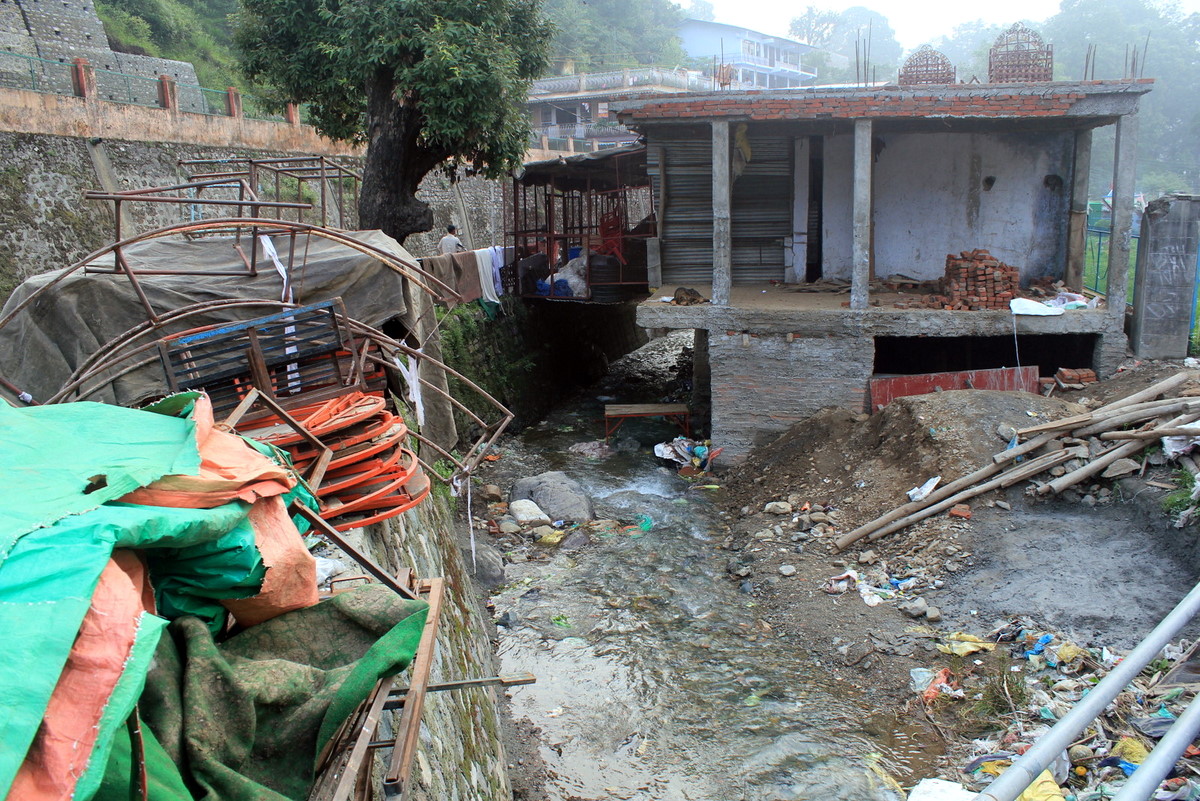When development becomes a synonym of concrete structures and long trails of vehicles creeping along the hill roads…
Bhowali, a valley-like settlement 10 km downhill from Nainital, was once known for the brief sojourning of stalwarts like Kamla Nehru and KL Saigal in the historical TB Sanatorium it has. Many know it for being the fruit basket of the central Himalayan region. It is where most of the roads leading to the interiors of the Kumaon Himalayas converge, thus keeping it vibrant with the transit rush of hill folk and tourists. Bhowali has become a classical simulacrum of earning a quick buck by playing fair or foul (mostly foul) in connivance with the conflating duo of the politicians having a myopic view of development, often with a motive pronounced enough to aggrandize themselves in all possible means, and the stained bureaucracy working as their touts.
There is a rivulet here having an ‘S’ shaped course looping the valley. It forms the natural drainage of the valley and is its only source of the fresh groundwater. With the increasing volume of water, as brooks running downhill keep on adding to its torrents, it becomes increasingly prone to flash floods. Flowing towards the northwest this gargling rivulet before joining the river Kosi bisects the sprawling campus of National Bureau of Plant Genetic Research (NBPGR). God alone does know for how long the once somnolent flow of this rivulet will be able to bear the excesses it is continuously being subjected to.
In 2003-04, just three years after the formation of the state of Uttarakhand, the first ever encroachment started right at the edge of this rivulet. A national daily raised this issue vehemently. A delegation of some concerned and senior citizens of the town approached the administration with the plea that the encroached land as per a Gazette Notification (No.3248-D/9-B-657-W-64 of July 8, 1964) belongs to the civic body which, thanks to its characteristic nonchalance, did never bother to apply for the mutation of the same. The delegation also pleaded that turning a blind eye to such an aberration would in due course divest the area of the only open expanse that served as a playground for children over the years. Save a hollow assurance that the matter would be looked into, the administration did never do anything.
This dilly-dallying on the part of the administration did write the very preface of the hazard that now looms quite large before the town. A whole lot of market consisting of everything from fast-food eateries to mutton-shop, provision-stores, green grocers, a temple and residential blocks has eclipsed the rivulet now. Transformation of seemingly makeshift structures of tin sheets – erected on cement platforms that rest on RCC pillars and foundations dug deep right at the heart of the stream and extended at times to the other bank of the rivulet – into permanent shacks has now become the order of the day. These structures have eaten up the willow trees that once lined this stream and its sloppy flow is often laden with the gradually mounting avalanche of garbage and plastic…and all this happened in the past eight years.
It will not be out of place to mention here that the flash floods caused in this stream following the heavy rains in 2010 besides its cost in terms of human life and property also blew off three bridges and much of roads along it. The quantum of destruction, if the floods repeat themselves, may well be imagined.
And this is situation when we have the Wetland (Management and Conservation) Rules 2010 of the ministry of environment and forests (MoEF); when we are one of the signatories of Ramsar Convention; when a rule dating back to the British era prohibits all constructions within a range of 50 feet from a water body; when the court verdict in the Ramakrishna Sevashram Trust vs State of Uttaranchal prohibits excavation and mining on riverbeds and so on. Interestingly, when some concerned citizens filed a PIL against the construction of multi-storey flats and a well organised series of efforts to convert the open expanse adjacent to the rivulet to a parking lot, the court ordered that no construction could be furthered there.
But all such things are rendered stale when development becomes a synonym of concrete structures and long trails of vehicles creeping along the hill roads. In olden times, especially in these hills, where natural hazards have always been an integral part of life, social values, faith, tradition and a sense of respect for wisdom gathered over the generations of co-existence with nature happened to regulate and shape the ethics of construction – still so conspicuous in old structures. But now, when whetting the human lust for immediate gains the market forces have been knocking off the very bottom of these traditional checks, we unfortunately are left bereft of any system to replace it. For the new generation of politicians in the state winning elections and keeping their vote bank pleased are more important; the masses want to make maximum hay while the sun shines and the ‘here today and gone tomorrow’ lobby of bureaucrats is absolutely blasé towards the call of mountains… Why get surprised then? We have a whole lot of Kedarnaths in the offing and Bhowali is just another number in the long list.
